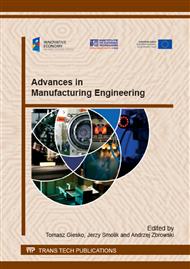[1]
http: /www. drewsystem. pl/Fotele-biurowe.
Google Scholar
[2]
http: /www. meble. com. pl/urzadzamy/108/na_czym_usiasc_za_biurkiem_35_krzesel_i_foteli _biurowych, 660. html.
Google Scholar
[3]
R. Ellegast, K. Kraft, L. Groenesteijn, F. Krause, H. Berger, P. Vink, Comparison of four specific dynamic office chairs with a conventional office chair: Impact upon muscle activation, physical activity and posture, Applied Ergonomics. Volume 43, Issue 2, (2012).
DOI: 10.1016/j.apergo.2011.06.005
Google Scholar
[4]
R. Goonetilleke, S. Feizhou, A methodology to determine the optimum seat depth, International Journal of Industrial Ergonomics. 27 (2001) 207-228.
DOI: 10.1016/s0169-8141(00)00051-2
Google Scholar
[5]
L. Groenesteijn, R. Ellegast, K. Keller, F. Krause, H. Berger, M. de Looze, Office task effects on comfort and body dynamics in five dynamic office chairs, Applied Ergonomics. 43 (2012) 320-328.
DOI: 10.1016/j.apergo.2011.06.007
Google Scholar
[6]
M. Lengsfeld, A. Frank, D. van Deursen, P. Griss, Lumbar spine curvature during office chair sitting, Medical Engineering & Physics. 22 (2000) 665–669.
DOI: 10.1016/s1350-4533(00)00086-2
Google Scholar
[7]
L. Groenesteijn, P. Vink, M. de Looze, F. Krause, Effects of differences in office chair controls, seat and backrest angle design in relation to tasks, Applied Ergonomics 40 (2009) 362–370.
DOI: 10.1016/j.apergo.2008.11.011
Google Scholar
[8]
T. Jindo, K. Hirasago, M. Nagamachi, Development of a design support system for office chairs using 3-D graphics, International Journal of Industrial Ergonomics. 15 (1995) 49-62.
DOI: 10.1016/0169-8141(94)00056-9
Google Scholar
[9]
EN 1335-1: 2009, Meble biurowe – Krzesło biurowe do pracy – Część 1: Wymiary – Określanie wymiarów.
Google Scholar
[10]
EN 1335-2: 2009. Meble biurowe – Krzesło biurowe do pracy – Część 2: Wymagania bezpieczeństwa.
Google Scholar
[11]
EN 1335-3: 2009. Meble biurowe – Krzesło biurowe do pracy – Część 3: Metody testowania.
Google Scholar
[12]
K. Matecki, S. Kozioł, T. Samborski, A. Zbrowski, Stanowisko do wyznaczania charakterystyk eksploatacyjnych leżysk mebli tapicerowanych, Pneumatyka. 2 (2010) 20-24.
Google Scholar
[13]
J. Dobrodziej, J. Wojutyński, K. Matecki, A. Gospodarczyk, M. Rogoziński, System badań trwałości i twardości leżysk mebli, Problemy Eksploatacji. 1 (2009) 27-44.
Google Scholar
[14]
PN-EN ISO 13857 Bezpieczeństwo maszyn. Odległości bezpieczeństwa uniemożliwiające sięganie kończynami górnymi i dolnymi do stref niebezpiecznych.
Google Scholar


